Access More Boat Tests
Already have an account? Login
Ranger Boats Reata 200F (2018-)
1 x 90-hp Mercury 4-stroke
Price
See the price by becoming
a BoatTEST member.
Members Must Log In
Key Features
- 9.5 gal. aerated livewell midship and aft
- Pre-wired for easy installation of optional trolling motor
- Bimini top
- Flush-mounted Lowrance Hook 5 fishfinder with GPS
- Stowable table
Test Results
| RPM | MPH | Knots | GPH | MPG | NMPG | STAT. MILE | NM | dBa |
|---|---|---|---|---|---|---|---|---|
| 600 | 2.3 | 2 | 0.4 | 6.4 | 5.6 | 185 | 161 | 48 |
| 1000 | 3.3 | 2.9 | 0.5 | 7.3 | 6.4 | 211 | 183.7 | 56 |
| 1500 | 4.7 | 4.1 | 0.9 | 5.5 | 4.8 | 159 | 138.5 | 65 |
| 2000 | 5.6 | 4.9 | 1.2 | 4.9 | 4.2 | 140 | 122 | 69 |
| 2500 | 7.4 | 6.4 | 1.6 | 4.6 | 4 | 132 | 115 | 67 |
| 3000 | 9.5 | 8.3 | 2.3 | 4.2 | 3.7 | 122 | 105.7 | 75 |
| 3500 | 11.6 | 10.1 | 2.6 | 4.5 | 4 | 131 | 113.9 | 77 |
| 4000 | 14.2 | 12.3 | 4 | 3.6 | 3.1 | 104 | 90 | 79 |
| 4500 | 17.6 | 15.3 | 5.1 | 3.4 | 3 | 99 | 86.2 | 82 |
| 5000 | 20.8 | 18.1 | 6 | 3.5 | 3 | 101 | 87.5 | 80 |
| 5500 | 23.4 | 20.3 | 7.2 | 3.3 | 2.8 | 94 | 81.8 | 80 |
| 5800 | 25.3 | 22 | 8.3 | 3 | 2.6 | 88 | 76.2 | 81 |
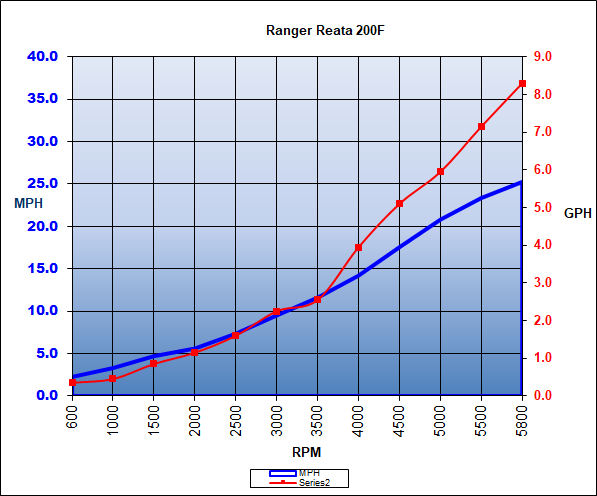
Specifications
| Length Overall | 21' 11'' / 6.68 m |
|---|---|
| Beam |
8' 6'' 2.59 m |
| Dry Weight |
1,780 lbs. 807 kg |
| Tested Weight |
2,482 lbs. 1,126 kg |
| Draft | N/A |
| Deadrise/Transom | N/A |
| Max Headroom | open |
| Bridge Clearance | N/A |
| Weight Capacity |
1,950 lbs. 885 kg |
| Person Capacity | 10 |
| Fuel Capacity |
32 gal. 121 L |
| Water Capacity | N/A |
| Total Weight |
2,482 lbs. 1,126 kg |
Acceleration Times & Conditions
| Time to Plane | N/A |
|---|---|
| 0 to 30 | 6.1 sec. (0to20) |
| Ratio | N/A |
| Props | Enertia 16x11x3 |
| Load | 2 persons, full fuel load, no water, 50 lbs. of gear |
| Climate | 65 deg., 48 humid; wind: 5-10 mph; seas: calm |
Engine Options
| Tested Engine |
1 x 90-hp Mercury 4-stroke |
|---|---|
| Std. Power |
1 x 90-hp Mercury 4-stroke |
| Opt. Power |
Not Available |
Contents of Report
- Overview
- Purchase Decisions
- Features Inspection
- Exterior
- Layout
- The Test
- Handling
- Pricing and Observations
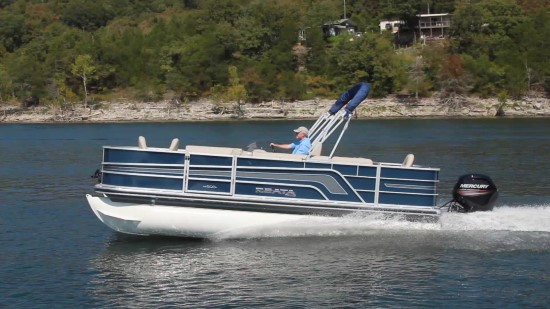
Overview
The Reata lineup comes in cruising or fishing versions, and the differences are plain to see at first glance. A forward gate with an open-bottom half to accommodate a trolling motor is the first clue to the boat’s mission being geared more towards fishing. Either way, the quality is evident right from that first glance where we see the more stylized 27” (68.6 cm) high fencing and those powder-coated logs. Add a matching trailer, and the package is complete eye candy on top of Ranger quality.
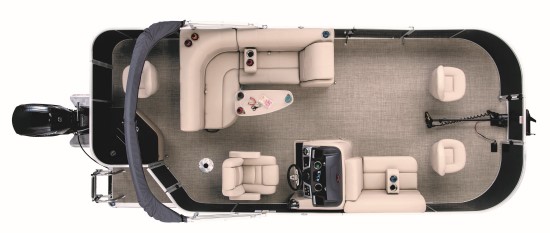
They are offered in three different fishing models and four cruising models, ranging in length from 20’ - 25’ (6.1 m - 7.62 m). Most notable are the amenities that are offered as options on most other brands are, here, included as standard. This includes powder-coated logs, premium vinyl flooring, fiberglass consoles, snapless mooring cover, easy-deploy bimini, reclining captain’s chair, tilt steering, and marine-grade upholstery. All are wheelchair accessible.
Purchase Decisions
When selecting your Reata 200F, the first question to ask is… what color. Ranger offers five choices with no up-charge. Choose from Black Metallic fencing with Black logs, Light Charcoal fencing with Black logs, White with Black logs, Matador Red with White logs, and the colors of our test boat: Blue Metallic with White logs.
Power Choices
Unlike many other builders, Ranger offers the Reata Pontoons with choices, not only for horsepower but also brand. Get your Reata powered with Mercury, Evinrude, or Yamaha with power ranging from 25-hp - 90-hp.
Now, before you balk at 25-hp being offered, there are a few things to consider. First, it’s not a ploy to get a lower number in the MSRP, as in “starting at only $X!” Ranger actually prices the Reata with a 60-hp Merc 4-stroke as a base, and if you decide that you only want to move up the lazy river at a slow pace, then the 25-hp gets you an $1,800 credit.
Second, some people actually live on small lakes or streams where there are horsepower limits. Offering 25-hp allows them to get on the water with more boat.
So, 60-hp is the base, and a 90-hp will run between $1,800 for our Merc, $2,000 for a Evinrude, and $2,300 for a Yamaha.
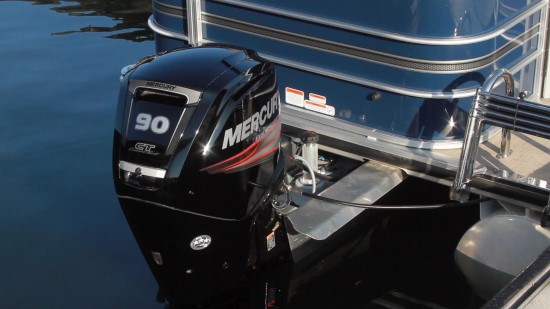
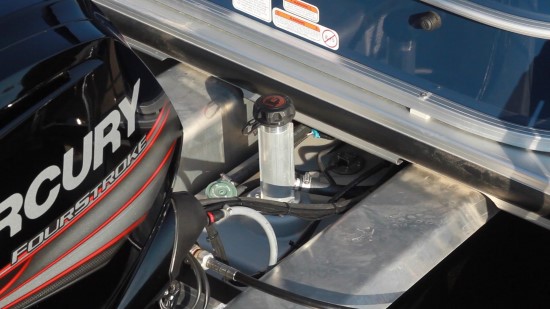
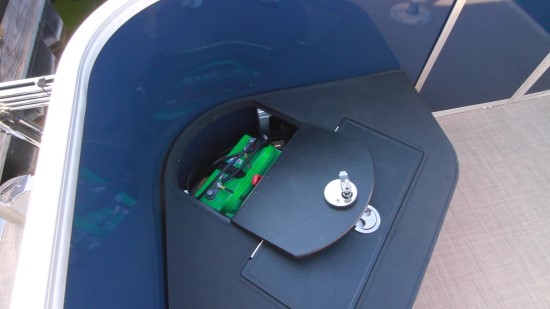
Options
Then we add options. A ski tow will add $450. The trolling motor comes in two versions: the MotorGuide W55 with remote for $670 or the Minn Kota 55-lb. (25 kg) with co-pilot for $1,120; both will be dealer-installed. Trailers are also optional, and you can choose from single axle ($2,000), single with brakes ($2,300), dual axle ($2,800), and dual with brakes ($3,000).
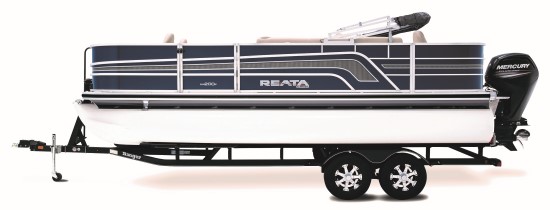
Features Inspection
Fishing
Let’s start our inspection by looking at exactly what makes this such a fish-friendly pontoon boat.
•Forward fishing station -- Two swivel pedestal seats are fully forward.
•Two aerated livewells -- The livewells are aerated, timed, and high-capacity at 9.5 gallons (36 L).
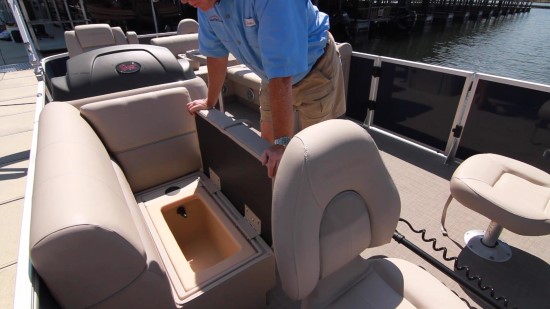
•Lowrance Hook-5 electronics -- Come standard at the helm console.
•Ample rod storage -- Both vertical and lockable rod storage on larger models.
•Prewired for trolling motor -- Select a 55-lb. (25 kg) from Minn Kota or MotorGuide.
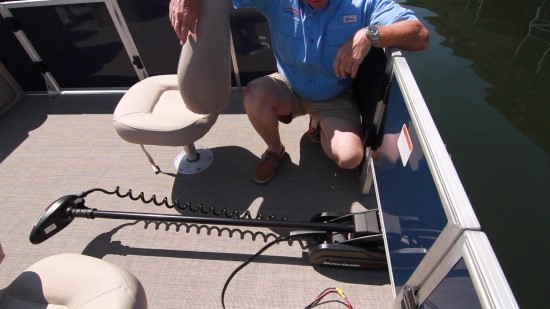
•Aft fishing station -- It includes tool and rod holders on larger models, livewell, and swivel seat on this one.
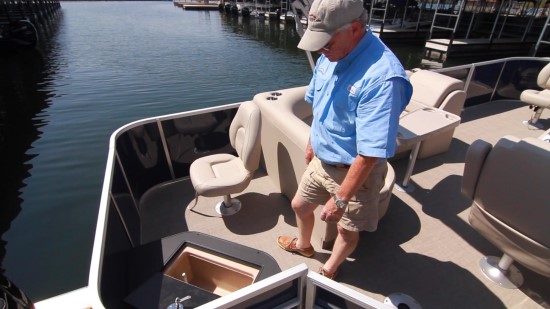
The Exterior
Externally, these are great looking pontoons, and that says a lot in a market where they all tend to look the same. Here, the fences have a much more stylized design that clearly stands out. More so are those powder-coated logs. This will be the bane of existence of marinas that charge a premium for acid washing the aluminum tubes, but so be it. Powder coating not only keeps longer, it’s easier to maintain and looks much richer and avails itself to many colors.
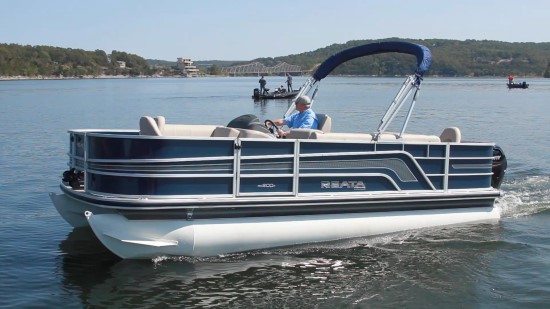
There are three boarding positions: a forward gate at 23” (58.4 cm), a portside gate at a wheelchair accessible 30" (76.2 cm), and a stern gate at 15” (38.1 cm) leading to the swim platform.
The Layout
Of course, the 200F isn’t just for fishing. She’s also a great entertainment platform with a roomy layout that starts with the two forward pedestal seats. They can swivel, and the seatbacks can fold down flat to the seat when not in use. Snap-straps hold the seatbacks in the closed position. They fold up on pinchless hinges. A lounger is just behind and to starboard, ahead of the helm.
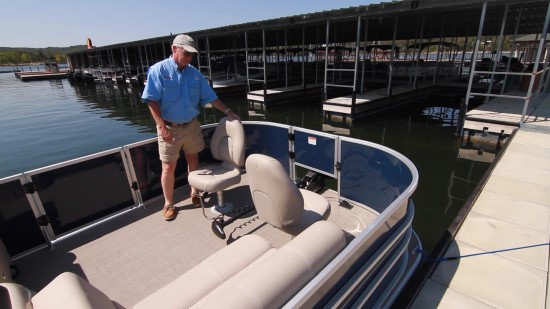
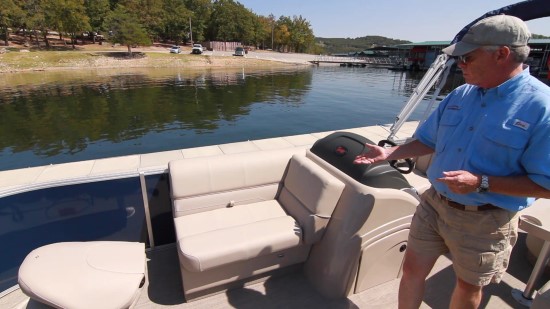
Continuing aft, Ranger included an L-shaped sofa to the port side that has a floating beverage holder/armrest. The sofa wraps around a pedestal base for a table. Speakers are mounted to the seat base. A pop-up changing room is at the forward end.
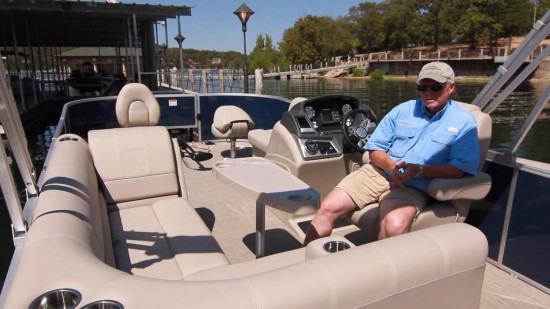
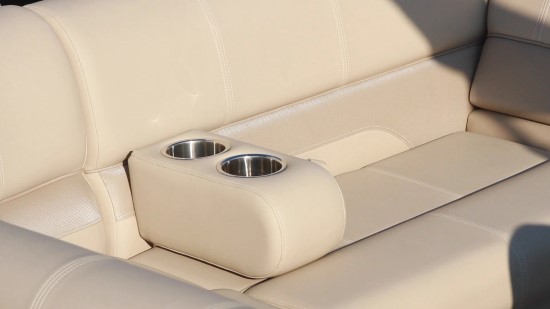
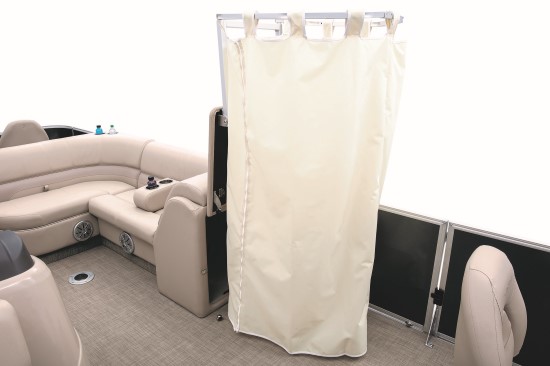
Behind the L-shaped sofa is the aft fishing station with a single pedestal seat and another livewell mounted in the starboard corner. A gate is also to starboard leading to the swim platform and beefy stainless steel ladder.
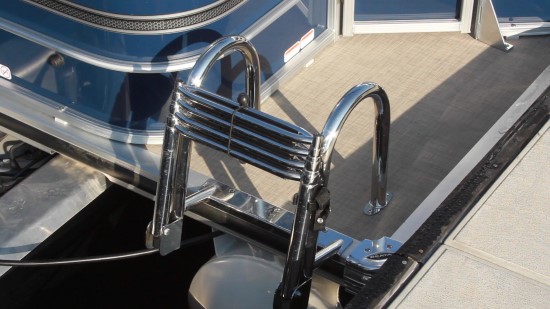
Decking is all premium vinyl, which is a nice departure from the carpeting over the marine-grade plywood that we typically see. Carpet doesn’t shed water the way vinyl does, and this increases the lasting power of the decking overall. The woven style leaves a little to be desired from a non-skid perspective, but that’s a small criticism considering that we’re not exactly going to be heading offshore any time soon.
The vinyl is also easier to hose off and the fences are slightly elevated off the deck, so washdown water runs right out.
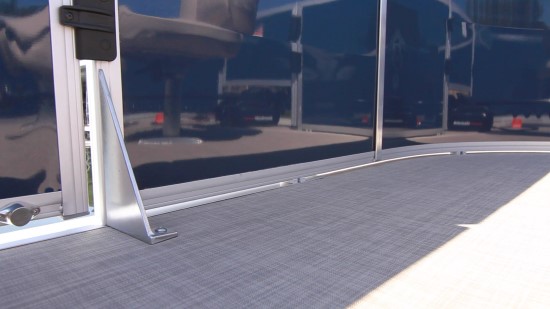
Overhead is an improved version of a bimini top that we’re happy to see. Ranger’s focus groups zeroed in on the bimini as being the biggest headache in this market segment -- Ranger decided to do something about it. It typically takes two people to deploy and secure a typical bimini top, but not so here. Gas-assist and easy-release mechanisms make this not only a one-person operation; it’s one handed. Up it goes, unfurl it, and just like that, 7’ (2.13 m) of overhead protection. And it’s color-keyed to the boat’s color.
The Helm
Ranger is proud of its helm on the 200F, and with good reason. Being fiberglass, it’s a welcome departure from the molded plastic versions we typically see. It’s also rife with quality good looks and style.
Aside from the Hook-5 display taking center stage, the panel is also outfitted with white-faced gauges against a darker background. A phone management system consists of two recessed pockets with USB and MP3 connectivity to supplement the Bluetooth stereo. The wheel is mounted to a tilt base.
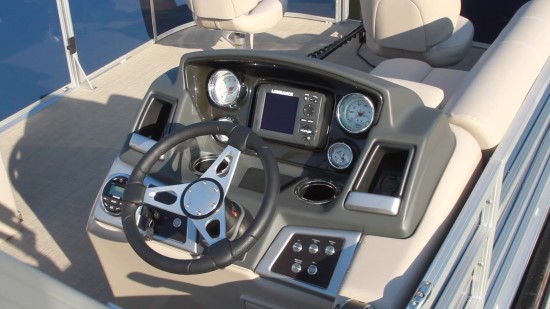
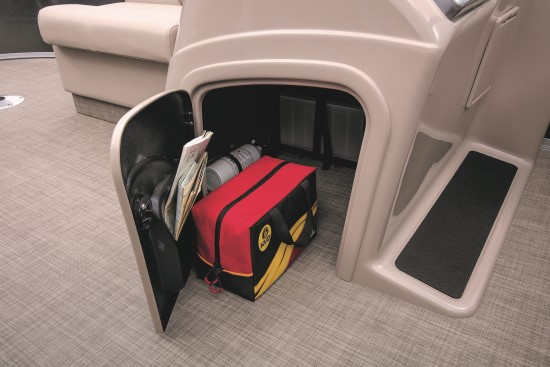
The Test
The Ranger Reata 200F has an LOA of 21’11” (6.68 m), and a beam of 8’6” (2.59 m). With an empty weight of 1,870 lbs. (848 kg), full fuel, and two people onboard, we had an estimated test weight of 2,482 lbs. (1,126 kg).
With a 90-hp Mercury four stroke turning a 16x11 Enertia propeller, we reached our top speed of 25.3 mph at 5800 rpm, and this with a full load of fuel and two people. Best cruise came in at 3500 rpm and 11.6 mph. At that speed, the 2.6 GPH fuel burn translated into a range of 131 miles all while still holding back a 10% reserve of the boat’s 32-gallon (121 L) total fuel capacity.
Handling
She’ll accelerate to 20 mph in an average of 6.1 seconds. Once up to speed, bring the trim up to get her into a 5-degree bow high attitude to produce best cruising results. You’ll see the spray move back to the stern and become relatively non-existent. She is sensitive to weight distribution, so with a few people in the bow she’ll ride more level, but the trim will still help the propeller bite better. She will lean slightly to the outside of a turn, as is the usual case with a two-log pontoon boat. Crossing wakes shows no adverse effects such as hull slap or pounding. In fact, she is quite comfortable with this. She’s also a surprisingly dry boat with no spray coming from the side of the tubes when trimmed, and at the stern, the engine pod has its own spray rail that keeps things well under control there.
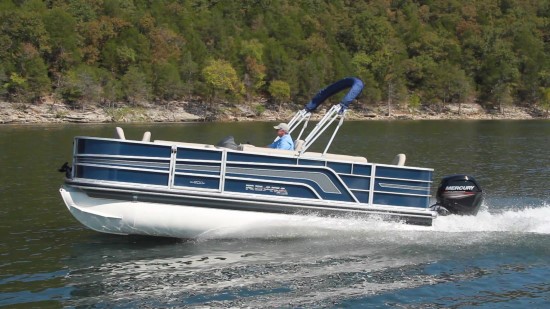
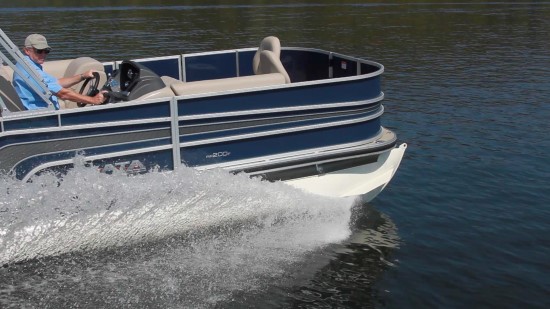
Pricing and Observations
Depending on how you want to equip your 200F, it can run from a base price of $24,995 on up to $29,465 with top tier choices on all equipment. It’s hard to find a bargain in this market, but Ranger has certainly zeroed in on one with this well-equipped and well-built pontoon. It’s feature-packed with very few options offered as there is so much included as standard.
